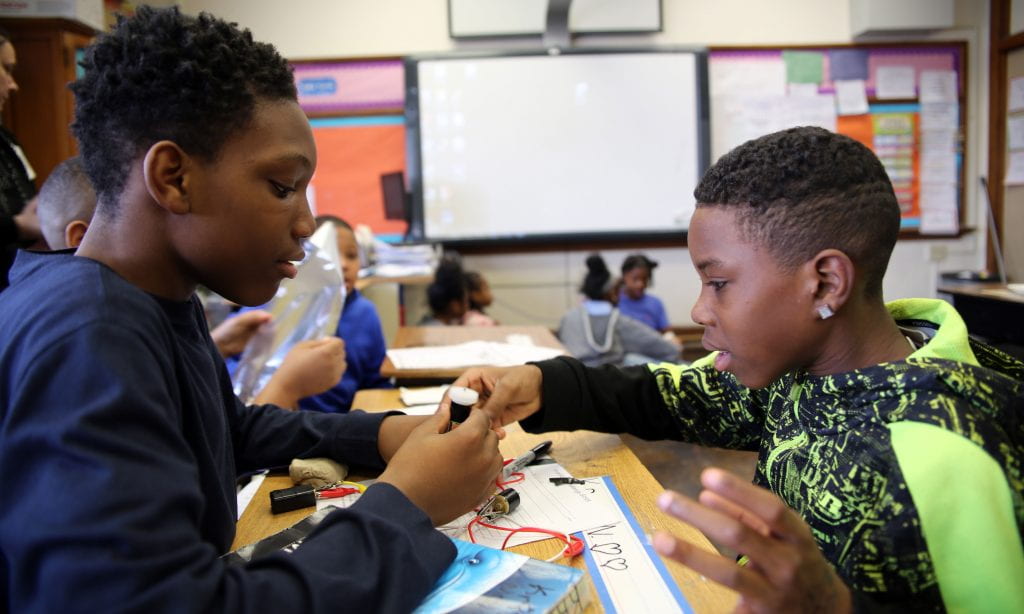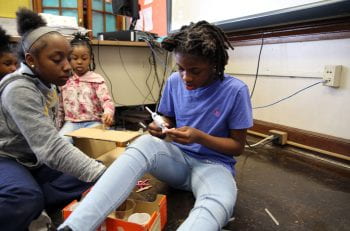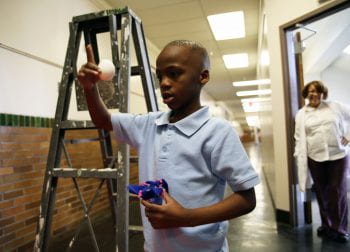It’s mid-afternoon at Walbridge Elementary School and the hallways are buzzing. Literally. Electronic buzzer sounds spill out of classrooms as students work on circuitry projects.
Jaime Gilligan, with Washington University’s Institute for School Partnership (ISP), is touring the school with principal Mildred Moore. Walbridge is one of several schools in the St. Louis Public School District that are piloting a new STEM (Science, Technology, Engineering and Math) curriculum and teacher training program called mySci Do. It’s modeled on mySci’s distribution protocol and was designed to apply those methods to technology education. It’s funded by a grant from the Monsanto Fund, and developed by the ISP, Maryville University School of Education, The Little Bit Foundation and The Disruption Department.
Change is hard, and implementing a new curriculum at Walbridge was no exception. Therefore initial reservations about how to facilitate makerspace learning in a classroom,but the teachers quickly adapted, says Moore. Once they saw the kits and accompanying lesson plans they were fully onboard.
“The kits enhanced the learning experience by giving students the opportunity to play with a purpose,” she explains. “They were able to think like engineers by using critical thinking skills to solve real-world problems.”
mySci Do is coordinated by the joint efforts of the ISP and The Little Bit Foundation – an organization that provides basic needs to more than 9,000 students in 31 of the poorest schools in the St. Louis area.The schools receive a kit of maker materials and curriculum, introducing them to robotics and constructivist learning. The teachers are trained by the ISP and Little Bit personnel.
Welcome to science in the real-world
Sitting on the floor, several fifth-grade girls work in pairs, they pass a glue gun between them. They’re keenly focused on the task at hand – an invention challenge that involves identifying a problem facing them or their community and prototyping a solution using circuitry sets of power buzzers, motors and lights. Paper cups and strands of masking tape, foil and pipettes are scattered around them.
“The iterative design process that they are using here is a critical skill that can be applied in all kinds of scenarios,” Gilligan says.“ They’re practicing empathy, defining a problem, ideating multiple solutions, prototyping an option, testing their prototype and giving and receiving feedback which informs their revisions.”
On this day, Gilligan and Moore also visit with students in kindergarten and second-grade.
Down a long hallway stands a ladder surrounded by red paper. Dozens of second-graders mill out of their classroom and sit in front of the display. They carry precious cargo – their egg drop designs. They were challenged to design a contraption using various materials to protect a raw egg from a high fall, inspired by the book Egg Drop by Mini Grey.
The air is buzzing with excitement. Hands fly up in the air for a turn to drop their egg contraption. Slowly and carefully the students climb to the top of the ladder. At the top they pause. The egg design hangs in the air. Will it? Won’t it?
Quickly the egg drops to the tarp below. Splat! Yellow yolk drains from the broken design. The next student takes his place on top of the ladder and quickly drops his egg. Will it? Won’t it? Carefully he reaches for his egg design and ever so gently peels back the top. Success! His egg is intact. Triumphantly, he holds it up in front of him to show his classmates. Each of his classmates records their observation on a chart for the class to discuss later.
Standing in the doorway behind him, principal Moore beams.
“The excitement of the students and teachers grew each week as they became more involved in the design phase of the lessons,” she says. “Teachers became very proud of the students’ designs and began to invite others in to see the designs and listen to the students explain their work.”
Bring innovative learning experiences to students
For this pilot year, mySci Do was only offered to schools served by The Little Bit Foundation. The goal was to bring innovative learning experiences to students who may not otherwise have the opportunity to learn, build and share 21st century innovations
Moore says the support the students receive from the Little Bit Foundation is extraordinary. The Foundation provides free uniforms, shoes, coats and toiletries to students to ensure they are properly dressed. The students are able to maintain a positive self-esteem by being able to wear the same clothing (uniforms) as their same age peers.
So what prompted Little Bit to partner with the ISP to bring the mySci Do experience to their schools? That’s an easy answer for Little Bit program coordinator Dana Swanson to answer. She says mySci Do is a wonderful complement to its programming.
“We work to remove barriers to children succeeding in school and with mySci Do we are offering students programming that lets them get excited about the possibilities of their future. All of this goes hand in hand to help empower students and allow them to work towards their full potential.”
Little Bit program manager Ashley Gill says there’s a compelling need in our region for a program like mySci Do – which creates equitable access to 21st century, hands-on STEM experiences.
“Science and math are two subjects that are fairly daunting to students, and even adults. mySci Do strips away some of those intimidating thoughts in a fun, creative way and encourages kids to be creative and engage with the world around them in a different way than with just worksheets and textbooks.”


